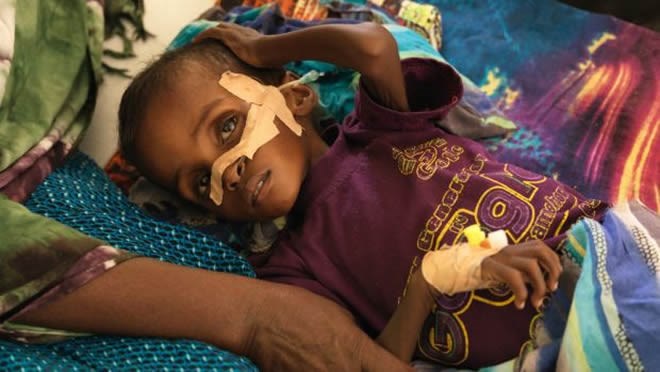
Thursday April 13, 2017
By Lisa Davies

Niman Adan Gabush, 2, is a severe malnutrition case at Hargeisa Group Hospital in Somaliland. Photo: Peter Caton/Red Cross Aus
Sending our journalists and photographers into world trouble-spots is a big responsibility. But when senior reporter Matt Wade requested approval to go to the Horn of Africa region to uncover the unfolding humanitarian crisis there, he said something that made the decision easy.
"I believe we can make a difference covering stories like this, and it makes a statement about what The Sydney Morning Herald stands for."
About 20 million people – the equivalent of nearly the entire population of Australia – is at risk of death in Africa right now as famine ravages Nigeria, South Sudan, Somalia and Yemen. It is a frightening story that needs to be told.
What Matt produced was a stunning piece of journalism. Written from Somalia and presented in this beautiful way by our creative teams in Sydney and Melbourne, as well as delivered with an elegance in Saturday's newspaper, the story had the impact it deserved.
I asked Matt to reflect on his trip, undertaken with the Red Cross, and give you an understanding of what such assignments are like on a personal level. Here's what he wrote:
"Somalia is one of four African regions with a food emergency. None of these crises received the attention they deserve. They are difficult places to report on – poor security meant we always travelled with an armed escort.
"In a bid to illustrate the scale of the need I asked many of families that I met to show me the food they had in their houses. I was moved by what I found. When I put that question to Kawsar Muhumed, a 25-year-old mother of three, she pointed to a tatty white sack on the floor of her gloomy dome-shaped humpy and asked me to open it. Inside was half-a-cup of rice. That, and two handfuls of flour, was all she had left. Kawsar told me she and her family were relying on scraps donated by her neighbours to survive.
"Her youngest daughter, nine month-old Moraw, was severely malnourished and only half the normal weight for a child her age. Many mothers were eating little so they can give what they have to their children. Another young mother told me she is only having a meal about once a week.
"The scale of the crisis was brought home to me during a visit to the only specialised centre for the treatment of severely malnourished children in Hargeisa, the dusty capital of Somaliland. The ward was so overcrowded many malnourished infants were being treated on the floor. For some it was too late – five children had died at the centre in the previous week.
"Unless help arrives soon the situation is bound to get far worse."
In addition to his main piece, Matt also filed a piece on Jess Lees, an Australian aid worker who, at 28, is already a veteran of some of the world's worst humanitarian emergencies.
You can also read our editorial as published in this week's Sun-Herald here.
Matt last went to that region in 2011 and it was predicted by a representative from Save the Children that the journalism "helped unlock nearly $130 million from the Australian government for the relief effort".
The reaction so far has been subtle, but important. I received an email from the head of a different aid organisation, who described Matt's work as "on the cutting edge of international development storytelling".
It has been noted that the African food crisis has consistently failed to gain traction in the Australian media, but I hope you agree that reporting like this is worthwhile, if not critical – both for the need to help the global community in times of crisis, but also to show that we are committed to covering stories that matter, both here and abroad.